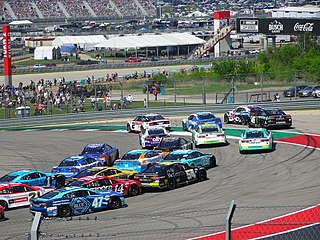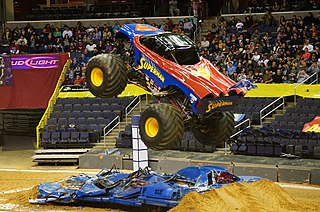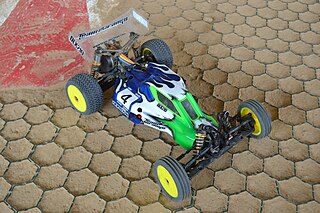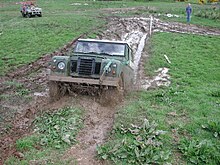
Auto racing is a motorsport involving the racing of automobiles for competition. In North America, the term is commonly used to describe all forms of automobile sport including non-racing disciplines.

Drag racing is a type of motor racing in which automobiles or motorcycles compete, usually two at a time, to be first to cross a set finish line. The race follows a short, straight course from a standing start over a measured distance, most commonly 1⁄4 mi, with a shorter, 1,000 ft distance becoming increasingly popular, as it has become the standard for Top Fuel dragsters and Funny Cars, where some major bracket races and other sanctioning bodies have adopted it as the standard. The 1⁄8 mi is also popular in some circles. Electronic timing and speed sensing systems have been used to record race results since the 1960s.
Radio-controlled cars, or RC cars for short, are miniature model cars, vans, buses, trucks or buggies that can be controlled from a distance using a specialized transmitter or remote. The term "RC" has been used to mean both "remote controlled" and "radio-controlled". "Remote controlled" includes vehicles that are controlled by radio waves, infrared waves or a physical wire connection. RC cars are powered by one of the three energy sources—electricity, nitro fuel or petrol. Electric RC models are powered by small but powerful electric motors and rechargeable nickel-cadmium (Ni-Cd), nickel metal hydride(NiMH), or lithium polymer (LiPo) cells with the former two being the most used. Both NiMH and LiPo have advantages and disadvantages in various RC applications where NiMH is mainly used for recreational and LiPo for more demanding purposes. There are also brushed or brushless electric motors—brushless motors are more powerful, long lasting and efficient, but also much more expensive than brushed motors.

The National Hot Rod Association (NHRA) is a governing body which sets rules in drag racing and hosts events all over the United States and Canada. With over 40,000 drivers in its rosters, the NHRA claims to be the largest motorsports sanctioning body in the world.

Funny Car is a type of drag racing vehicle and a specific racing class in organized drag racing. Funny cars are characterized by having tilt-up fiberglass or carbon fiber automotive bodies over a custom-fabricated chassis, giving them an appearance vaguely approximating manufacturers' showroom models. They also have the engine placed in front of the driver, as opposed to dragsters, which place it behind the driver.

Top Fuel is a type of drag racing whose dragsters are the quickest accelerating racing cars in the world and the fastest sanctioned category of drag racing, with the fastest competitors reaching speeds of 338 miles per hour (544.0 km/h) and finishing the 1,000 foot (304.8 m) runs in 3.62 seconds.

An all-terrain vehicle (ATV), also known as a light utility vehicle (LUV), a quad bike or quad, as defined by the American National Standards Institute (ANSI), is a vehicle that travels on low-pressure tires, has a seat that is straddled by the operator, and has handlebars. As the name implies, it is designed to handle a wider variety of terrain than most other vehicles. It is street-legal in some countries, but not in most states, territories and provinces of Australia, the United States, and Canada.

A monster truck is a specialized off-road vehicle with a heavy duty suspension, four-wheel steering, large-displacement V8 engines and oversized tires constructed for competition and entertainment uses. Originally created by modifying stock pickup trucks and sport utility vehicles (SUVs), they have evolved into purpose-built vehicles with tube-frame chassis and fiberglass bodies rather than metal. A competition monster truck is typically 12 feet (3.7 m) tall, and equipped with 66-inch (1.7 m) off-road tires.

A truggy is a type of high performance off-road racing vehicle that combines features from two older existing categories of off-road racing vehicles, trucks and buggies. The first truggies were built for racing in the SCORE and BITD off-road desert racing series, held in Mexico, California, Nevada and Arizona.

Off-roading is the act of driving or riding in a vehicle on unpaved surfaces such as sand, dirt, gravel, riverbeds, mud, snow, rocks, or other natural terrain. Off-roading ranges from casual drives with regular vehicles to competitive events with customized vehicles and skilled drivers.

The front-engine dragster is a type of racing car purposely built for drag racing. Commonly known as a "rail", "digger", or "slingshot", it is now considered obsolete, and is used only in nostalgia drag racing. Wheelbases ranged from 97 to 225 inches.
Dirt track racing is a form of motorsport held on clay or dirt surfaced oval race tracks often used for thoroughbred horse racing. Dirt track racing started in the United States before World War I and became widespread during the 1920s and 1930s using both automobiles and motorcycles. Two different types of race cars dominate — open wheel racers in the Northeast and West and stock cars in the Midwest and South. While open wheel race cars are purpose-built racing vehicles, stock cars can be either purpose-built race cars or street vehicles that have been modified to varying degrees. There are hundreds of local and regional racetracks throughout the nation. The sport is also popular in Australia, New Zealand, Canada, South Africa and the United Kingdom.

Truck and tractor pulling, also known as power pulling, is a form of a motorsport competition in which antique or modified tractors pull a heavy drag or sled along an 11-meter-wide (35 ft), 100-meter-long (330 ft) track, with the winner being the tractor that pulls the drag the farthest. Tractor pulling is popular in certain areas of the United States, Mexico, Canada, Europe, Australia, Brazil, South Africa, Vietnam, India and New Zealand. The sport is known as the world's most powerful motorsport, due to the multi-engined modified tractor pullers.

A swamp buggy, also known as a marsh buggy, is a motor vehicle used to traverse boggy swamp terrain. Swamp buggies may be purpose-built buggies or vehicles modified to traverse swamp terrain. Swamp buggies are capable of traveling through or over deep mud and water, moderately dense vegetation, and rough terrain possibly including logs and stumps. They may also be capable of floating in water or mud.

Sydney Herbert Allard was the founder of the Allard car company and a successful rally driver and hillclimb driver in cars of his own manufacture.

Seekonk Speedway is a family entertainment venue that features racing of all kinds on a semi-banked 1/3 mile asphalt-paved oval, located on U.S. Route 6 in Seekonk, Massachusetts.

The motorcycle sport of racing includes motorcycle road racing and off-road racing, both either on circuits or open courses, and track racing. Other categories include hill climbs, drag racing and land speed record trials.
The following is a glossary of terminology used in motorsport, along with explanations of their meanings.

Off-road racing is a form of motorsports consisting of specially-modified vehicles including cars, SUVs, trucks, motorbikes, quadbikes and buggies racing in off-road environments.

A 1:10 radio-controlled off-road buggy is a 1:10 scale radio-controlled dune buggy designed for off-road racing. These cars are based on their full-scale equivalents that are commonly found in desert racing. The buggies are split into two race categories, two (2WD) and four-wheel drive (4WD). These can easily be distinguished visually by their wheel size at the front. Cars are typically electric powered, but nitro versions do exist but are less common because racing classes exist for electric cars. The class is inexpensive and similar to a number of other classes, and this makes them popular with newcomers. The cars are also known as 1/10 off-road.



















